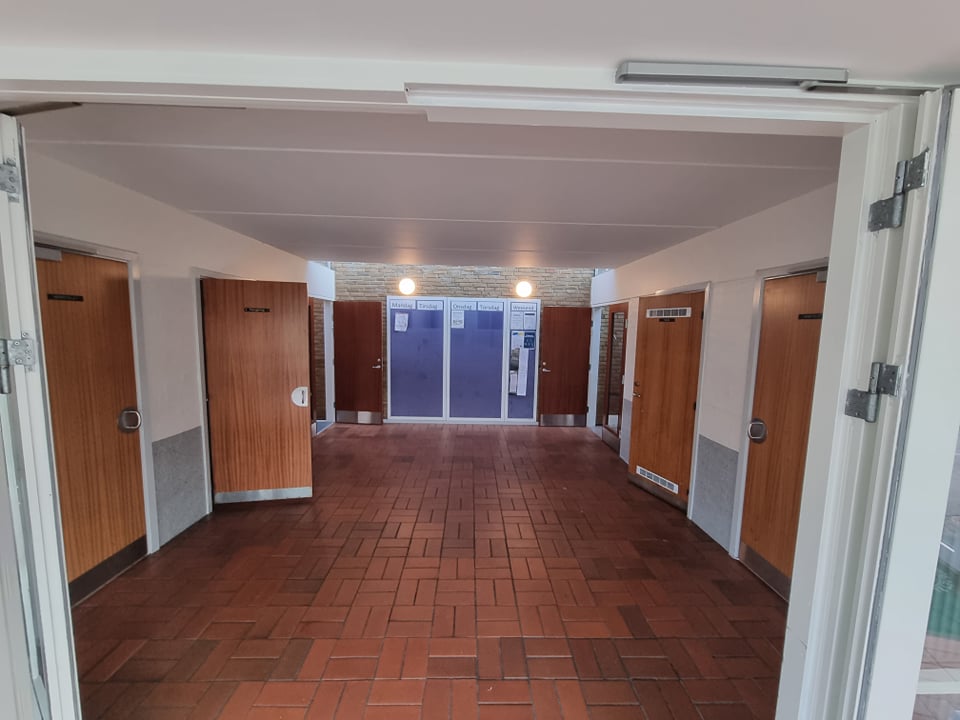AAB Silkeborg Sustainability Case
Members of the team:
Amanda Marie Holmegaard – aholmg21@student.aau.dk
Dennis Edward Kalinowski – dkalin21@student.aau.dk
Ida Isager Veng Valentin
Lasse Sand Dige – ldige18@student.aau.dk
Ninan Zhao – nzhao21@student.aau.dk
Miro link:https://miro.com/app/board/o9J_lm7bM-Y=/?invite_link_id=21052357460
Week 1 – Fieldwork & Problem framing
Day 1 – introduction to the case and formation of interview questions:
After a briefing on the AAU Silkeborg case, we used Miro to make an interview guide. Everyone started with self-brainstorming, after which we discussed our results and incorporated questions we liked into the final structure. We decided to structure the interview guide in three parts: questions about the current state (i.e. understanding); questions about the future state (i.e. desires); questions about the willingness to “pay” (i.e. how much do they really want those desires).
We had about three questions per section, for a total of nine. We put our questions into an interview worksheet to be used for Day 2.
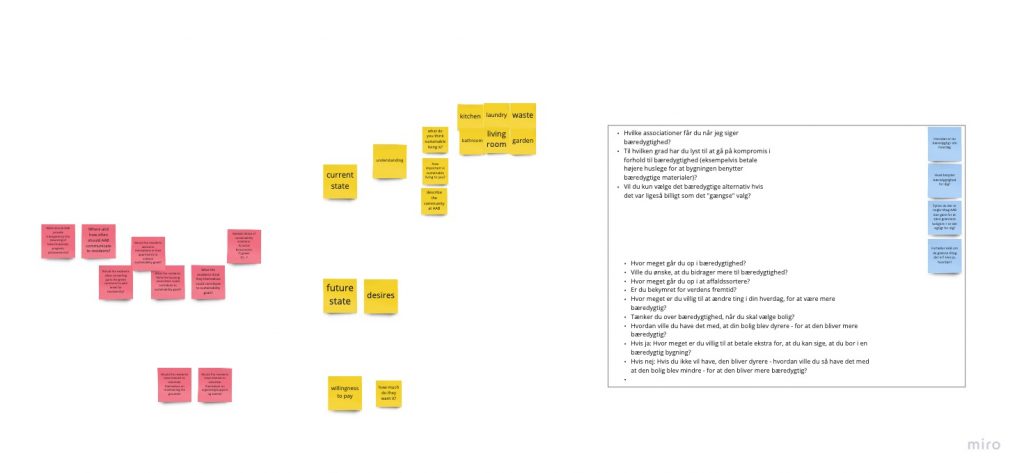
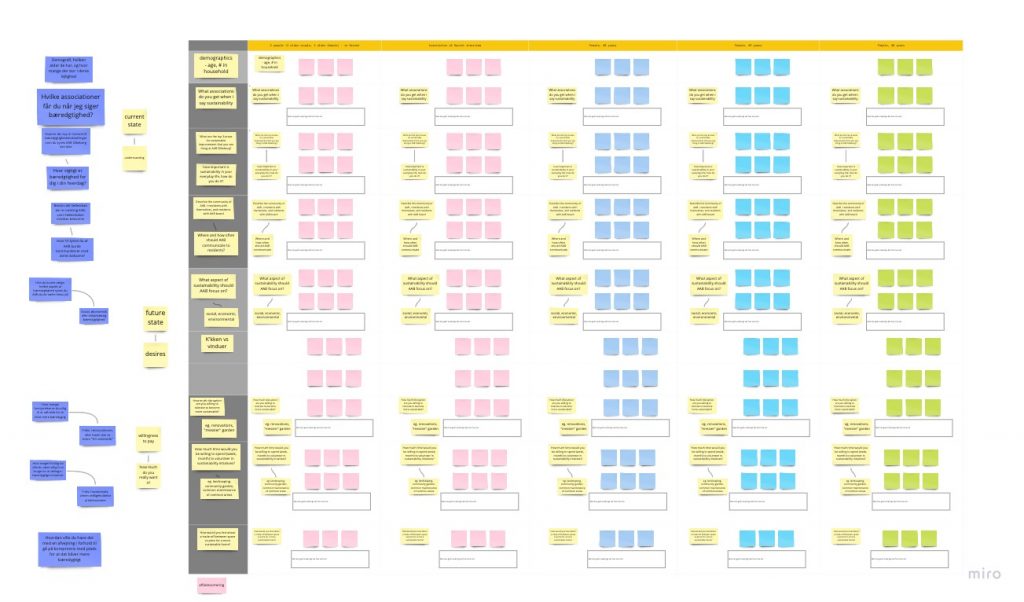
Day 2 – Conducting interviews on field trip to AAB Silkeborg:
On this day, we went on a bus trip to AAB Silkeborg to participate in a very informative meeting with Allan Oldenburg. He told us about the sustainability goals AAB Silkeborg aims to comply with. After the meeting, Allan gave a tour of the area that once was on the Danish government “Ghetto”-list. The tour showed the immense work that had to be done to make it attractive to the citizens of Silkeborg.
After the tour AAB and Allan had set up a meeting with some of the residents that provided crucial information on how they think about sustainability and how much discomfort they are willing to endure to meet AAB’s goals.
We split up and conducted a total of 2 group interviews with three people in each group, for a total of 6 people interviewed. Our raw interview results were transcribed into Miro.
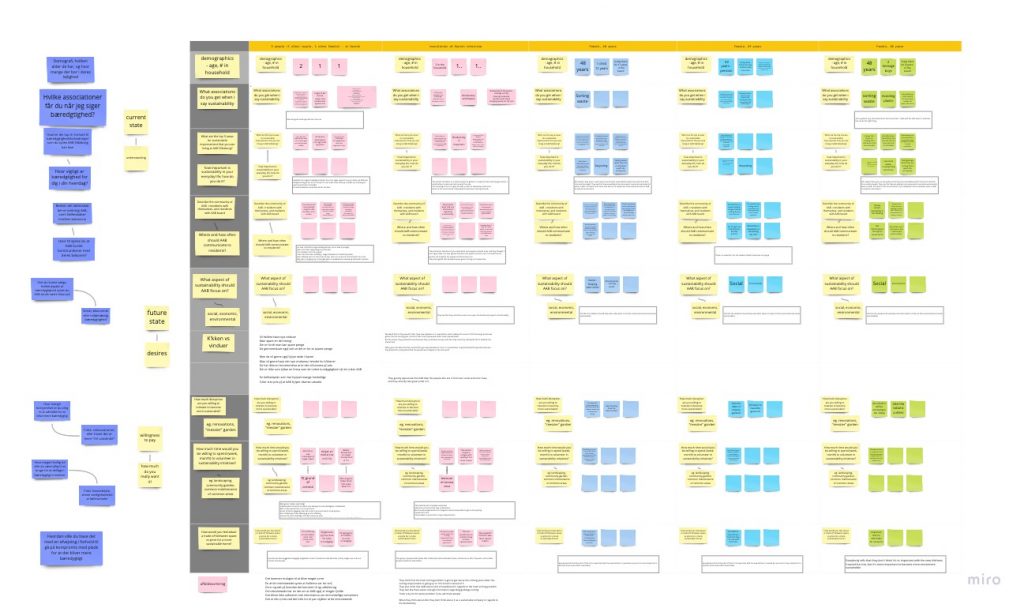
Day 3 & 4 – Framing the problem and analyzing the interviews
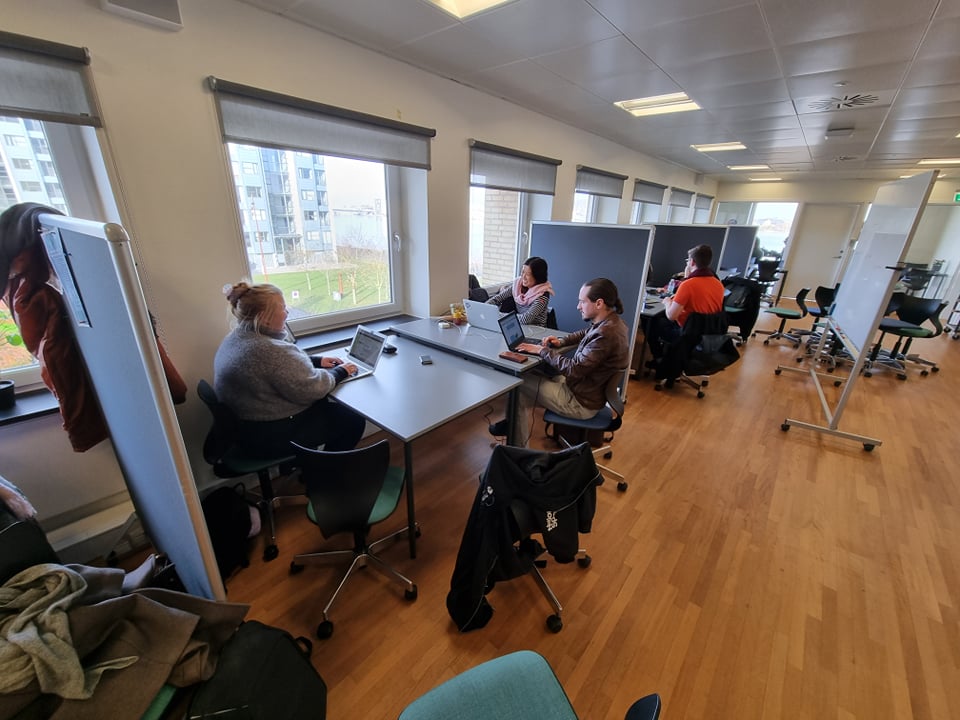
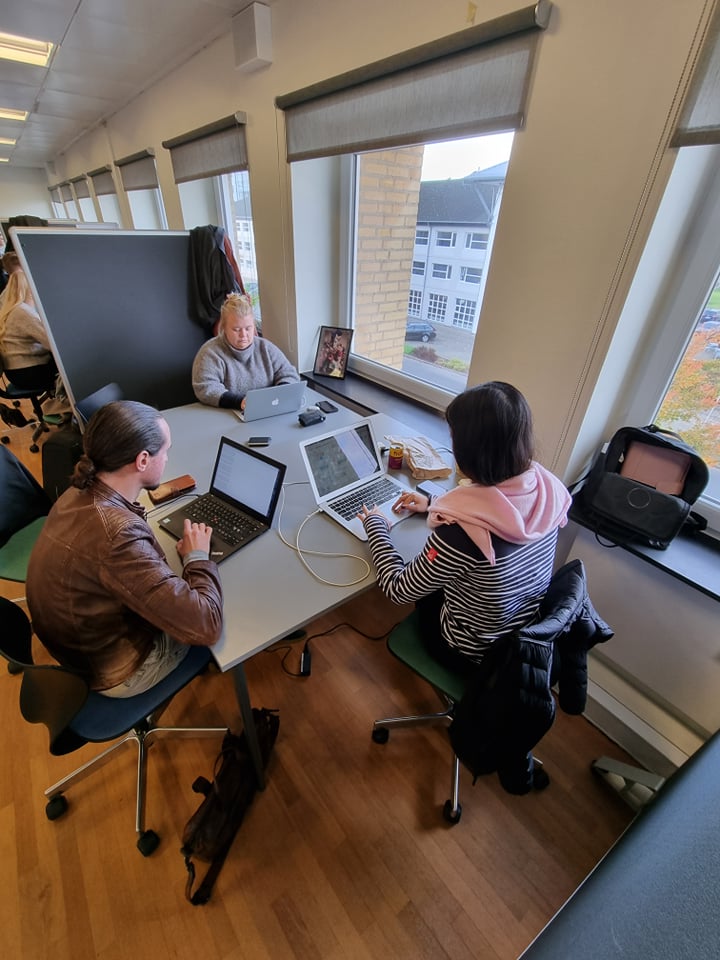

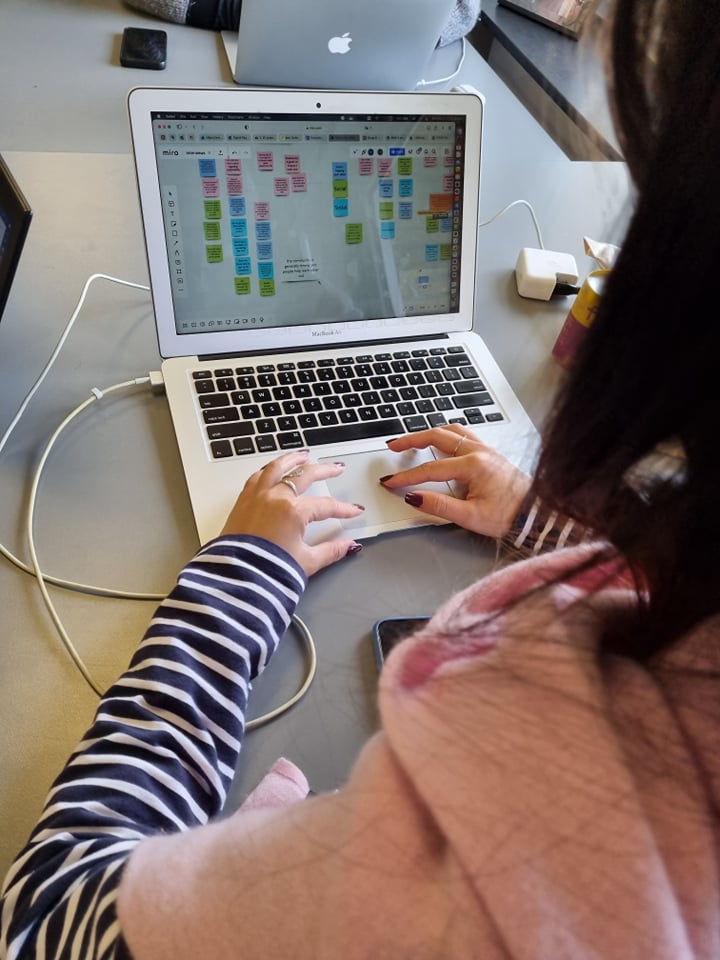
Ninan working on our affinity-diagram on the website Miro.com
Deliverables:
Affinity-Diagram
We took our raw interview results and cleaned them up so that each sticky note contained only one idea. Each interview set had a different color. Then, we tried to group the sticky notes together. An insight note (white sticky) was used to summarize the groupings and show our interpretation of the results.
As our interview guide consisted of 3 sections, so does our resulting affinity diagram. When reading our affinity diagram, the insight notes are sufficient; coloured stickies around the insight notes are “interview proofs” to support our interpretation. Sometimes a proof supports more than one insight. In those cases they were duplicated to appear under both insight stickies.
The three sections again are: the current state (i.e. understanding); the future state (i.e. desires); the willingness to “pay” (i.e. how much do they really want those desires).

Our overall affinity diagram. White stickies are insights, colored stickies are interview notes supporting proof of the insights.
Current state: Understanding
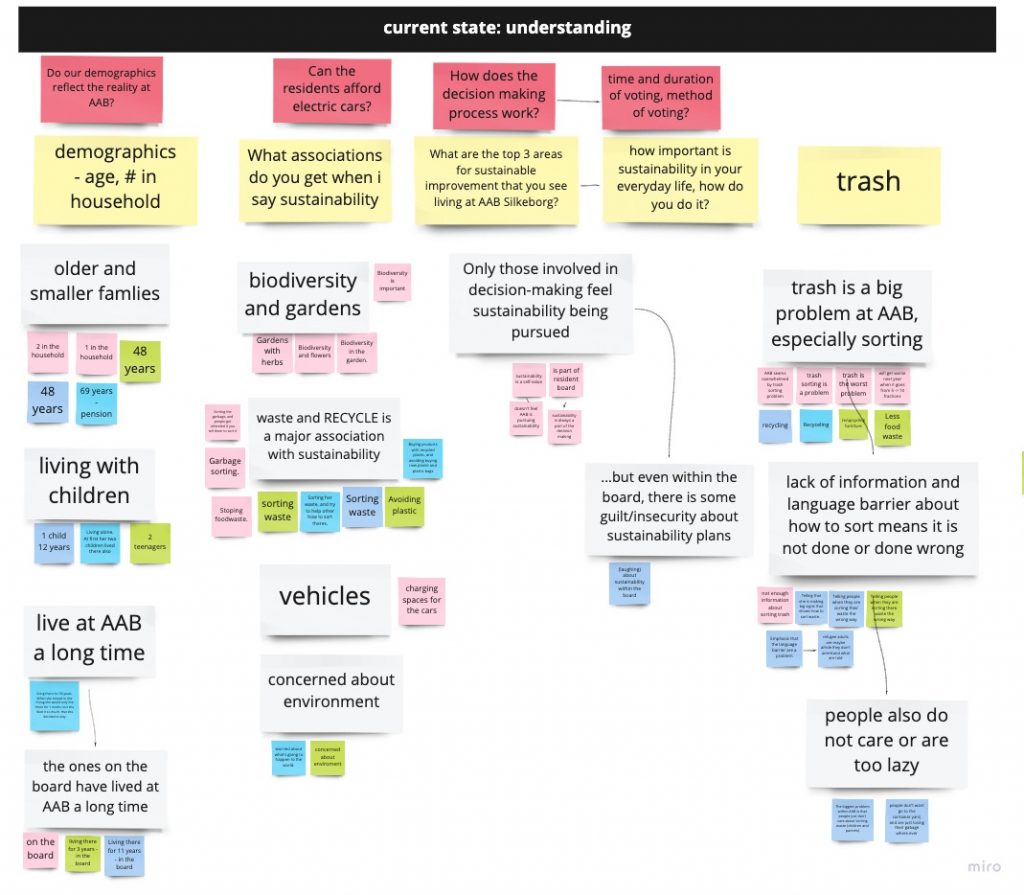
This section summarized our demographics, and the current understanding AAB residents have of sustainability topics. Generally, our interviewees have been living at AAB a long time, and are generally older with families. The major association they have with sustainability is biodiversity and gardens — so environmental sustainability. Only those members involved in the board and therefore the decision making processes feel like sustainability is being pursued by AAB. The biggest problem facing AAB now and in the future is trash and waste-related topics.
Future state: Desires
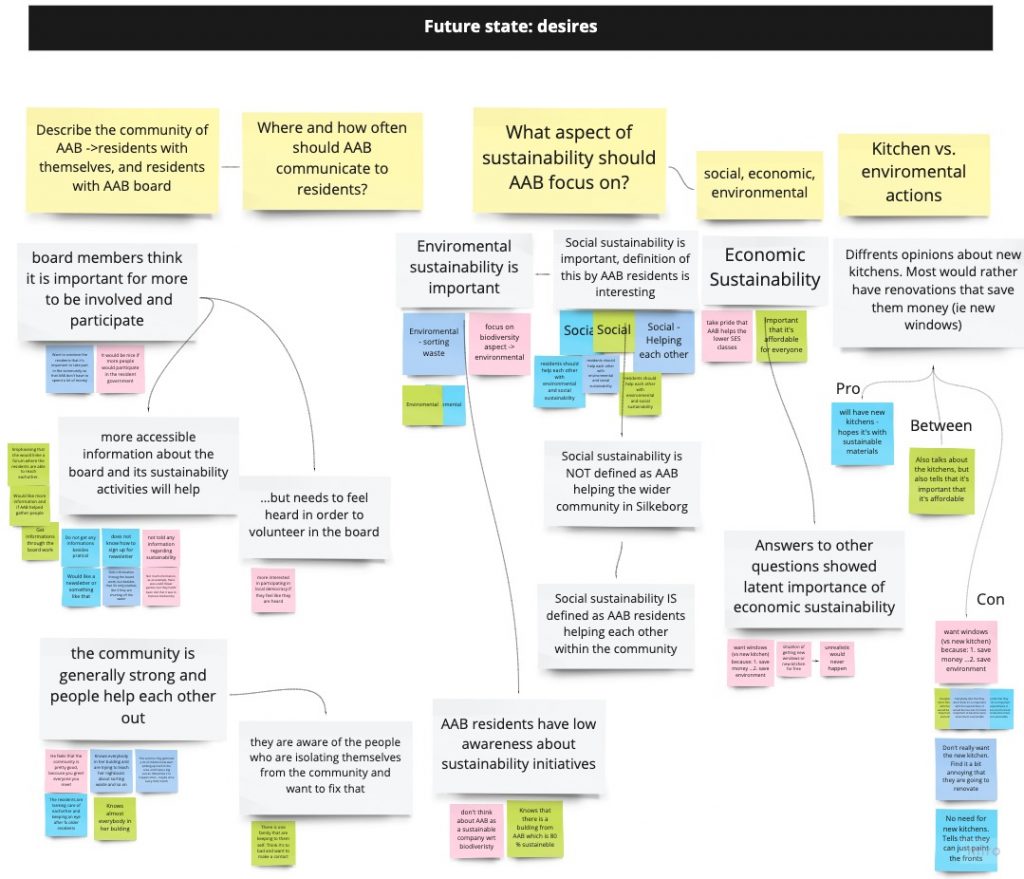
This section starts with an assessment on the community of AAB residents with themselves and with the board, and what aspect of sustainability they want AAB to focus on. Board members think it is important for more people to be involved and participate. Residents think AAB should focus on all three aspects of sustainability; the traditional environmental sustainability; social sustainability; economic sustainability was not directly stated as important, but from the answers residents gave to other questions, we discovered a latent importance of economic sustainability. We also asked an example question about if the residents would prefer a new kitchen, or environmental actions such as new windows. Generally, residents did not want a new kitchen, and would prefer actions such as new windows mainly so that they can save money on utility bills, with environmental aspects coming in second.
Willingness to “pay”
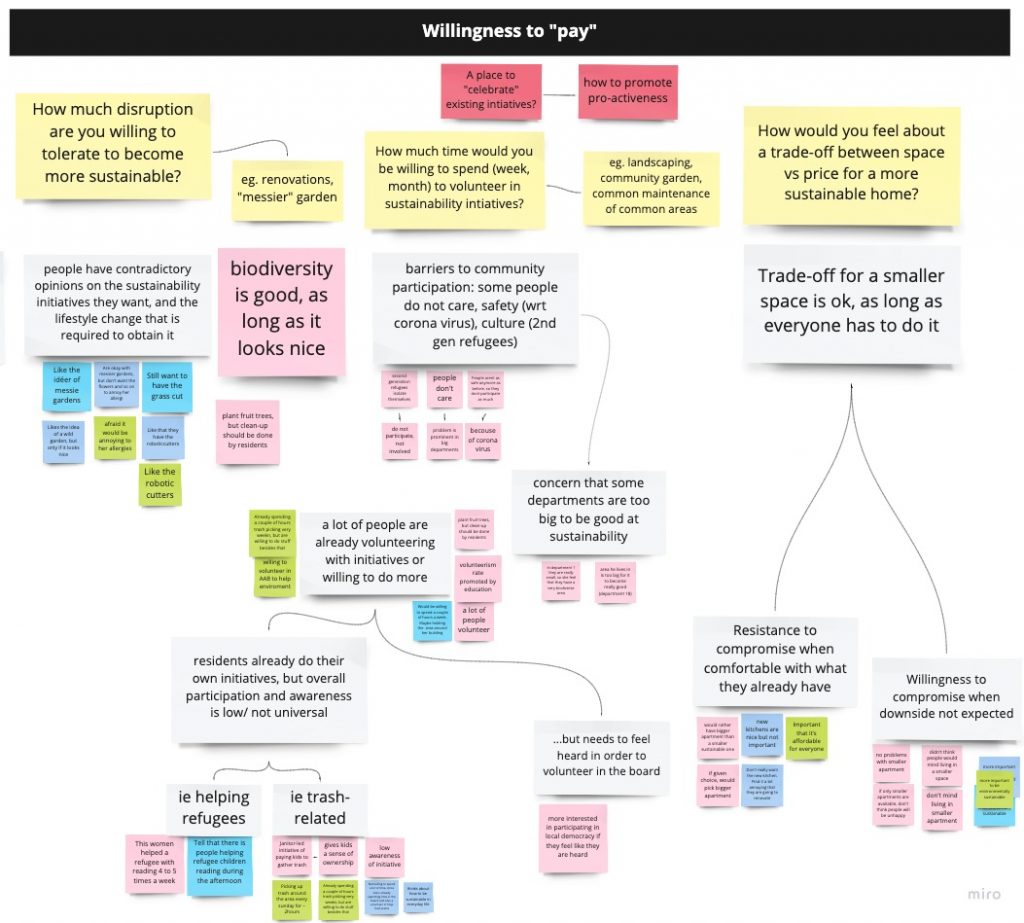
This last section tries to ask indirect willingness-to-pay questions rather than asking directly how much or how willing they are to pay for sustainability. We asked how much disruption residents would be willing to tolerate in order to become more sustainable. The examples we gave were renovations or having a “messier” garden. Residents had contradictory opinions on the sustainability initiatives they wanted, versus the lifestyle changes they are required to tolerate to make it happen. An interview quote that summarizes this incongruity is “Biodiversity is good, as long as it looks nice”. We also asked how much time or effort a resident is willing to donate to support sustainability initiatives. Residents are generally already volunteering and doing their own initiatives, but are willing to do more. Barriers to more community participation is safety (with regards to coronavirus), cultural differences, and lack of caring. There was also a concern that some departments are too big to be good at sustainability. Our last question asked about a trade-off between a smaller space, or a higher price for a more sustainable home. Analysis of the answers showed that people are okay with having a smaller space, but only if everyone has to also live in a smaller space. Perhaps this shows the importance of the community aspect of being sustainable together.
Day 5 – Core design resume
We took our affinity diagram and started brainstorming about the core values, that we could derive. Each group member sat for 15 min. and wrote down different values on post-it notes to use for our core design framework (Rosenstand & Vistisen, 2017). Afterward, each group member presented their value while discussing them with the group. This led to a lot of different ideas on how to put the values together and combine them.
We did not know beforehand, how many different core values we were going to end up with. After discussing the values, we ended up with four; sustainable community, sustainable image, transparency in decision and vision, and sustainable community again. The reason why we had two core values named sustainable community, was that there were different values attached to the different core values. Therefore we needed two.
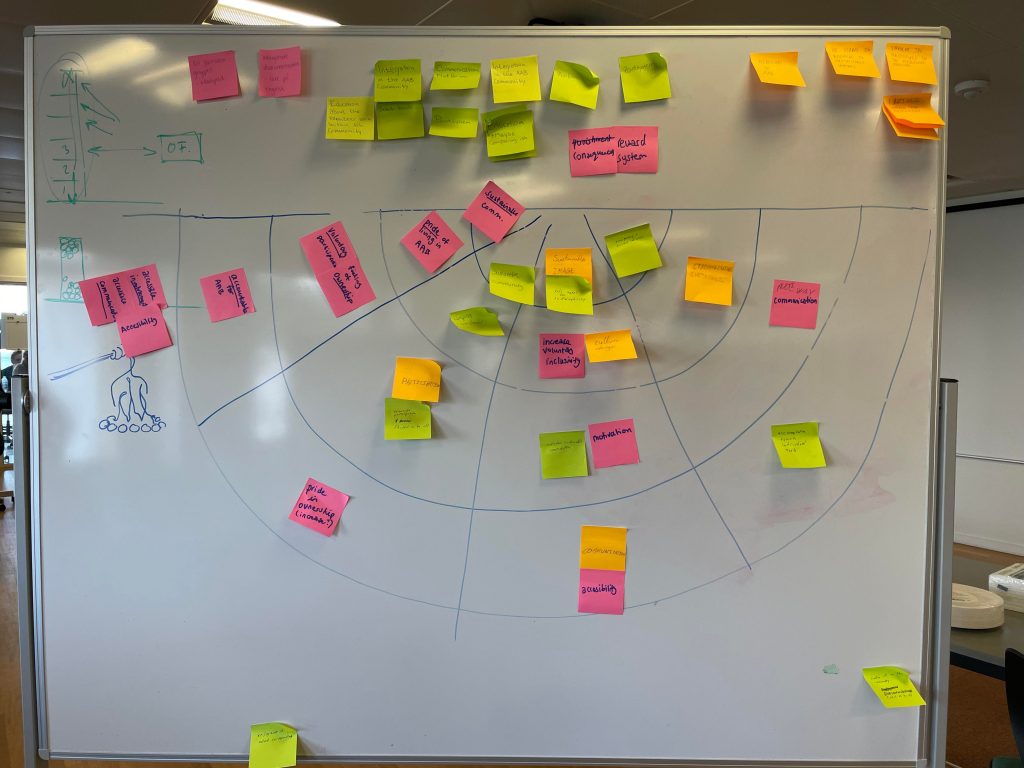
The first core value to be explained is sustainable image/ role model for sustainability, as seen in the middle of the circle. The values that is combined with this core value is first of all increasing voluntary inclusivity and culture change. The next values are motivation and sustainable motivation. The last two values combined are communication and accessibility.
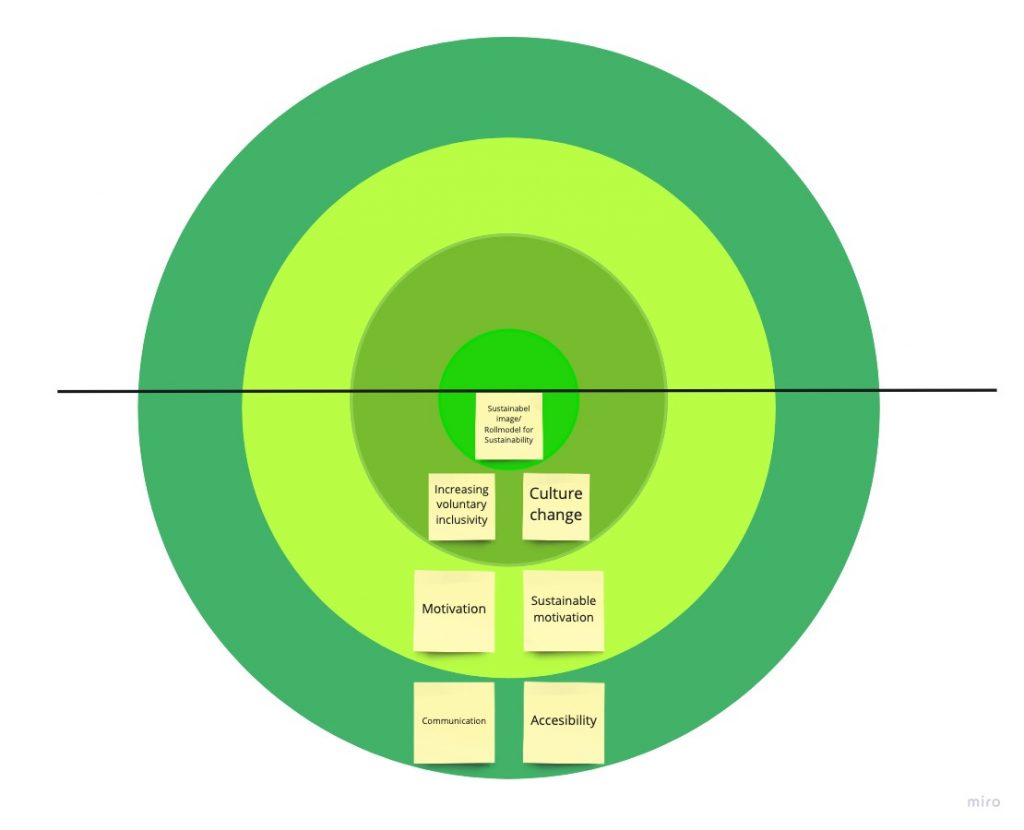
The next core value that we agreed on is transparency in decision and vision. The first value attached to the core value is streamlining sustainability. The next value attached is multi-way communication. The last value is accommodation towards individual needs.
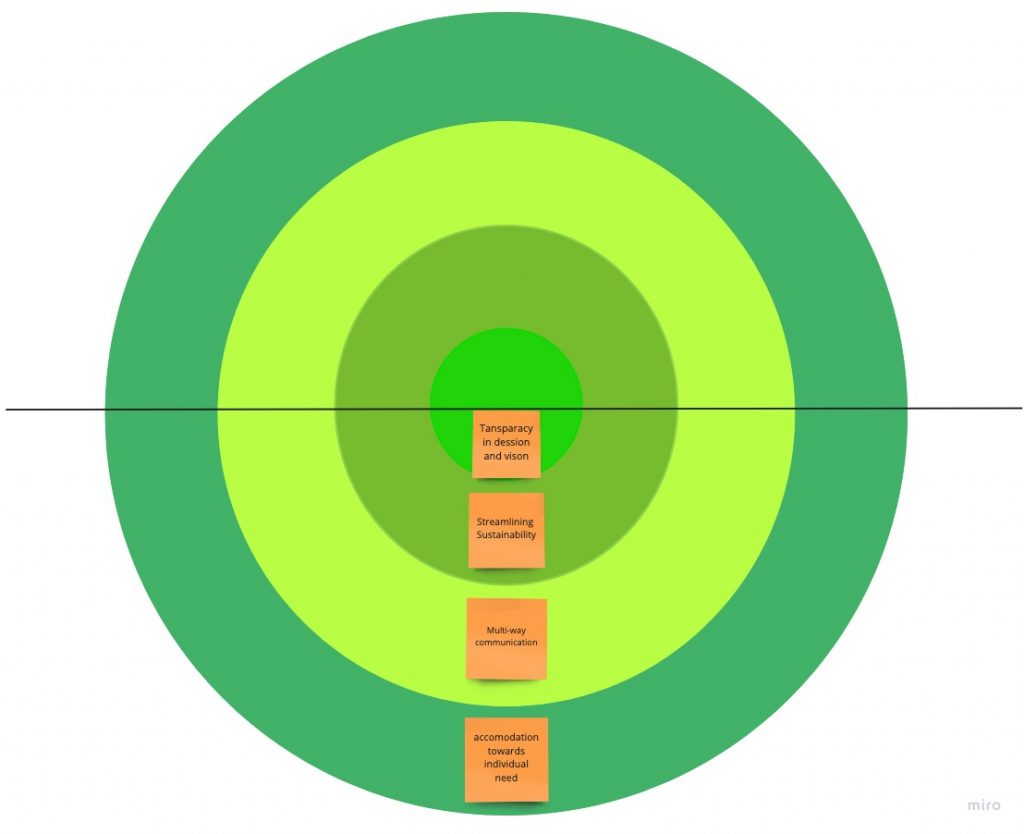
The third core value is a sustainable community. The two values attached to this value is helping out each other. Next, there are two values; participation and democratic participation.
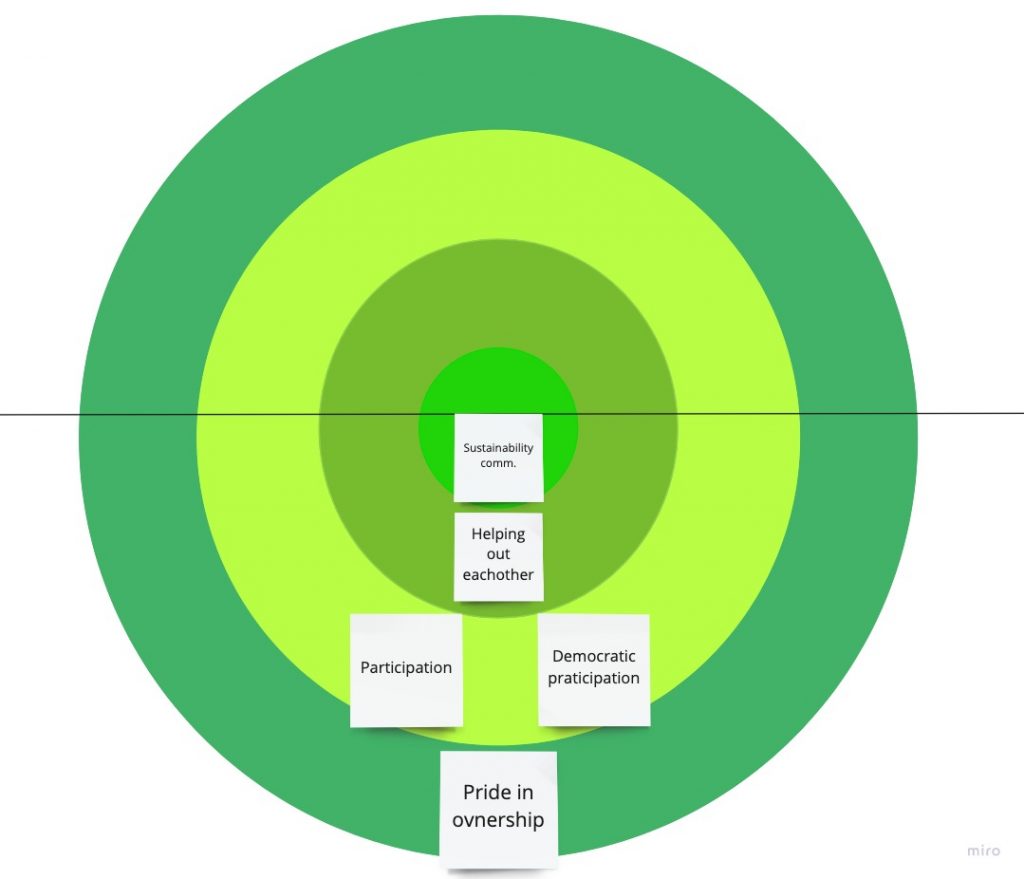
The last core value is the same as the one before, but with different values attached. The core value is a sustainable community. The first value attached to this one is the pride of living in AAB. The next ones are feeling of ownership and voluntary participation. The last value is accountable for AAB.
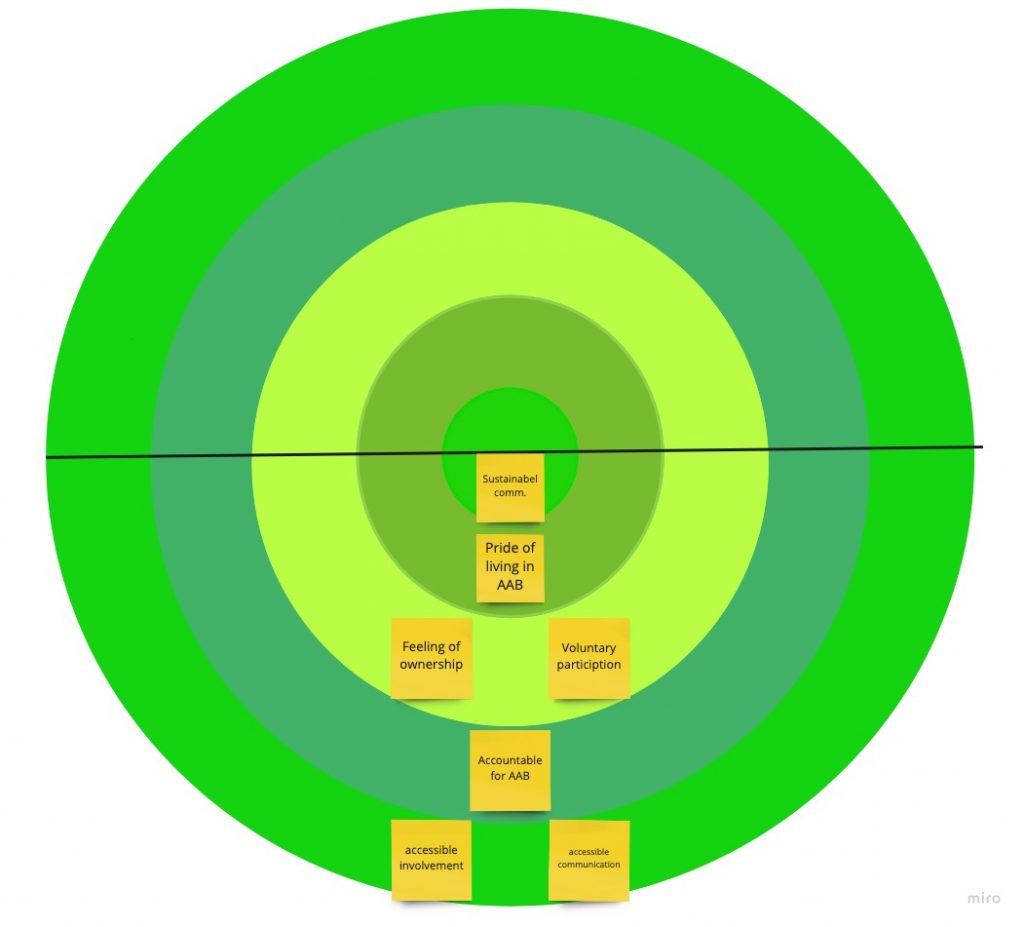
Conclusion to the core design
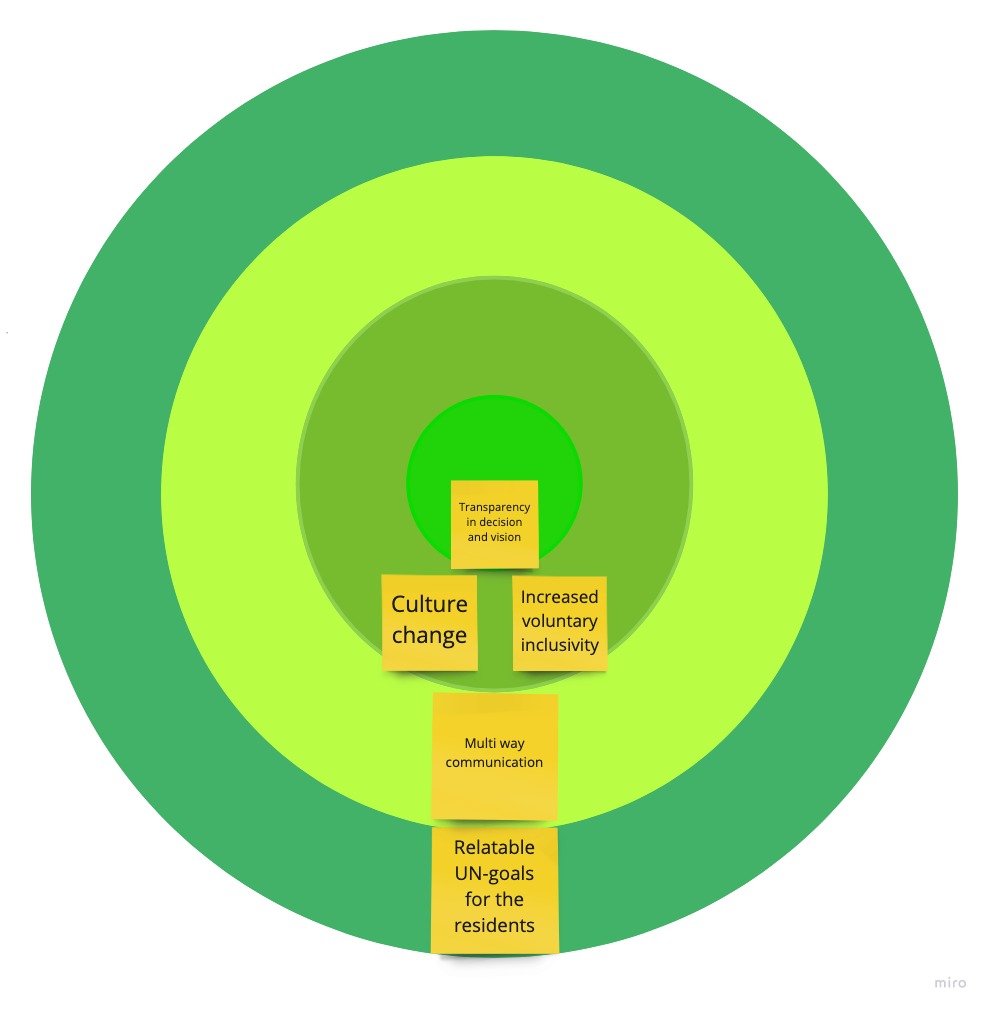
We presented data and observations to Allan, which Allan recognized as real. Then we presented the above core designs. Allan emphasized the most important to capture: AAB organization structured with bottom-up participation from residents, the UN goals should become relateable/essential to residents, and most importantly implemented with openness.
This then leads into a new final design blending values from our proposals:
- transparency in decisions and vision
- increase voluntary inclusivity
- involve all in multiway communication
- relateable UN goals for the residents
HMW question & Ideation framework
On this day we have the goals of creating an ideation framework that gives us a clear idea of how to solve the issues presented in the cores design.
The first step into making the deliverable was to brainstorm a lot of different “How Might We” questions that embody all of the values in our core value design.
This process was made in miro again as seen in the picture below.
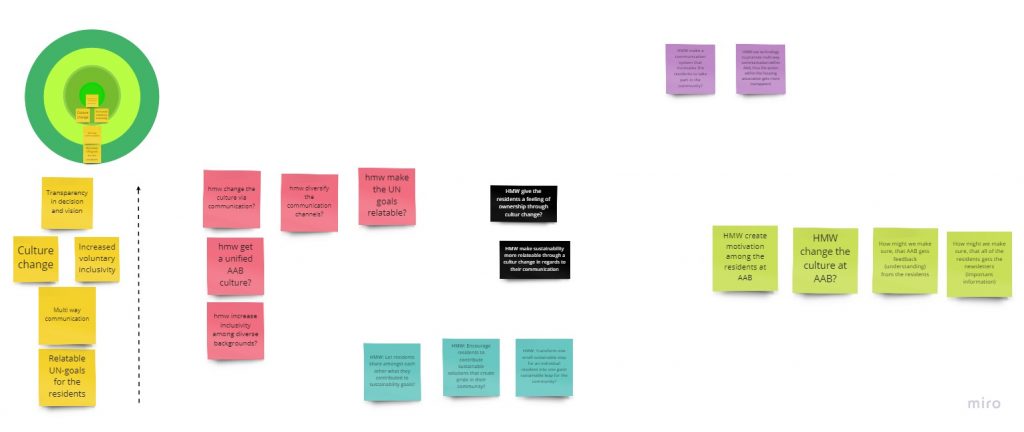
After the brainstorm, we reflected and choose 5 out of the 16 questions that we thought were the best questions. We ended up with the 5 questions seen below.
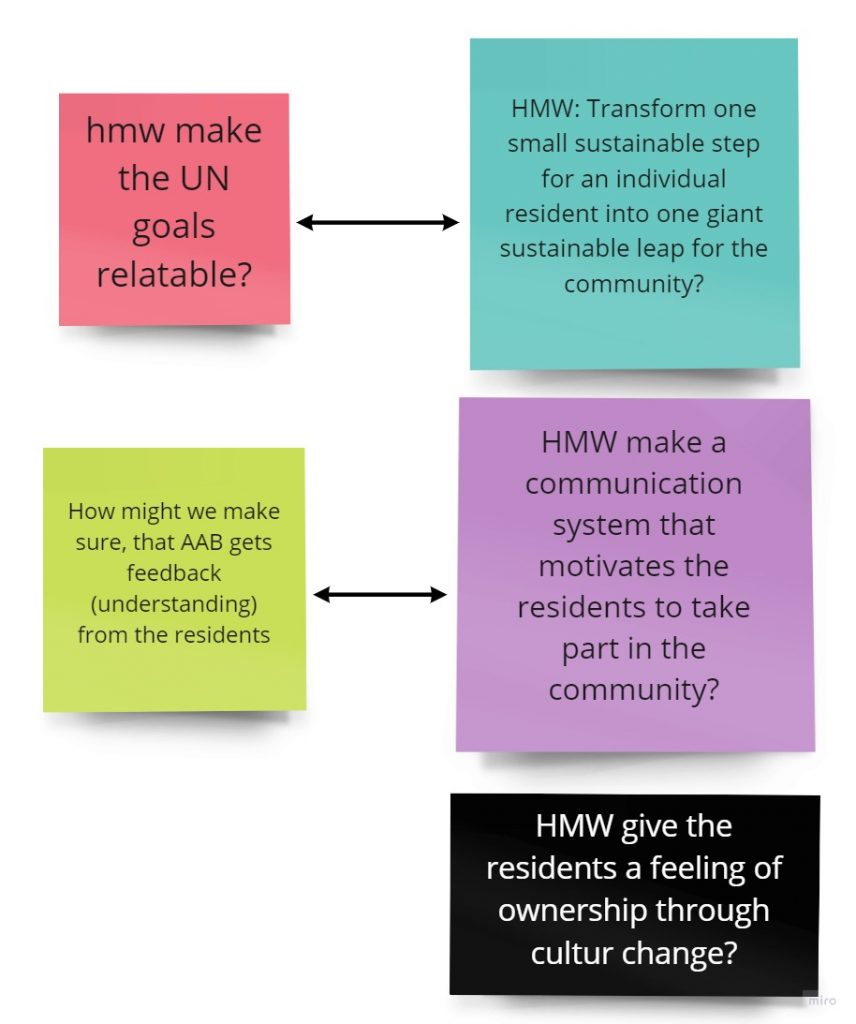
These 5 questions were then tried to be combined to make the best “HMW” question. As seen in the picture below, we had some suggestions simplified by the orange sticky notes, and we reflected and ended up combining them, creating the pink sticky note as our final “How might we”-question.
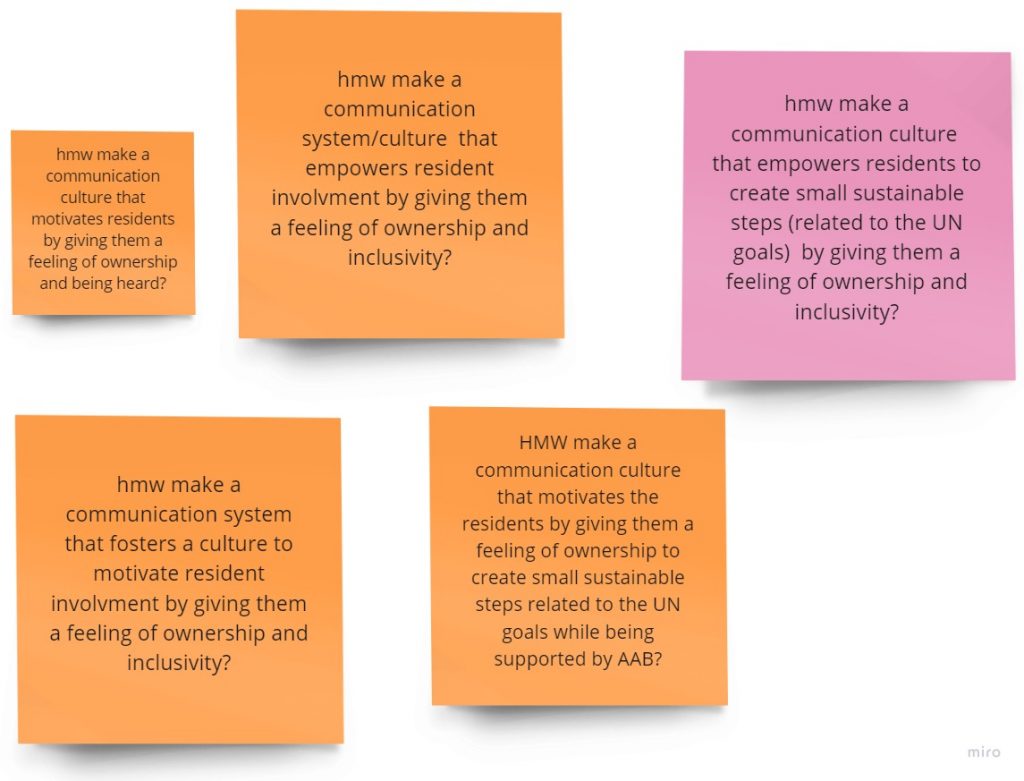
After choosing the HMW question above which wound as follows: “hmw make a communication culture that empowers residents to create small sustainable steps (related to the UN goals) by giving them a feeling of ownership and inclusivity?”, we made an IDÉ-KÚ in Miro, which gives us the ability to think and reflect over different solutions to the HMW-question. The IDÉ-KÚ is seen on the picture below.
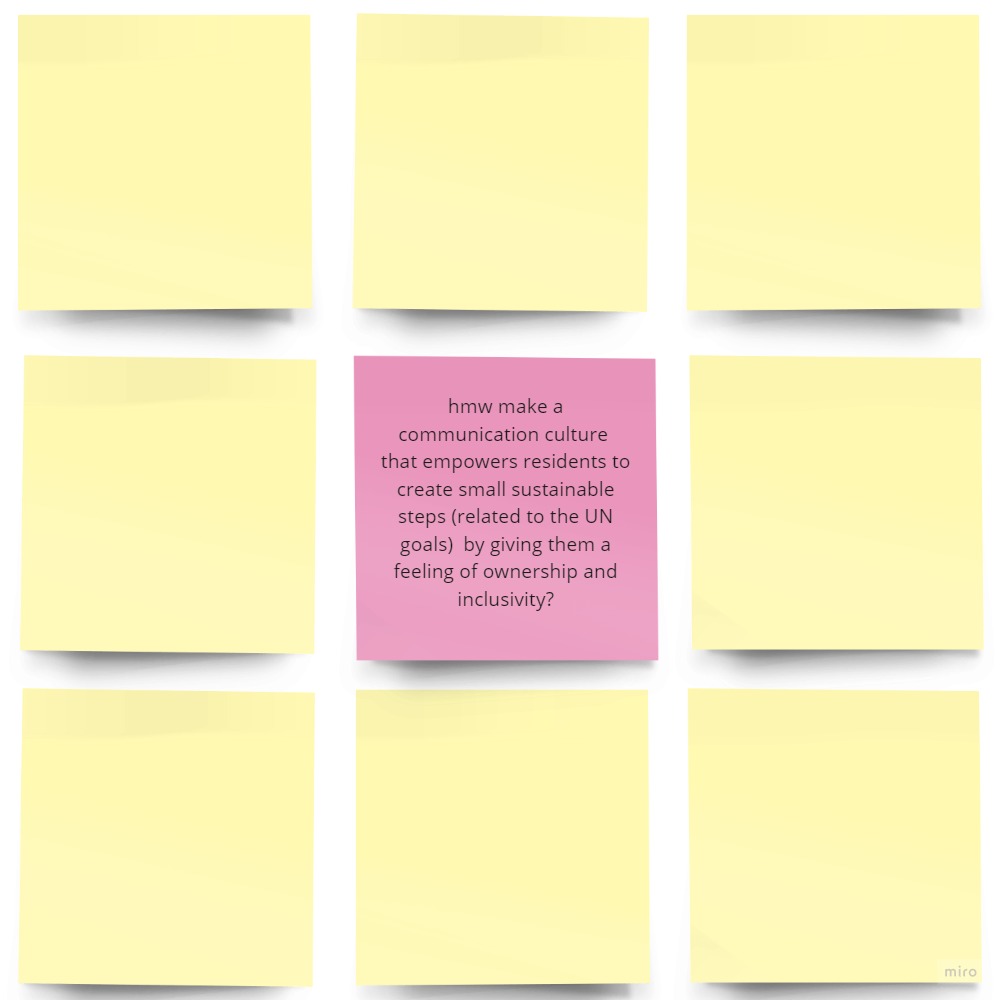
Each of us was then given 25-30 minutes to try and fill the sticky notes so that we were able to pick the best 5 solutions out of the 21 solutions that had been proposed. Before picking the best questions we clustered the solutions to create an overview of the solutions that we had.

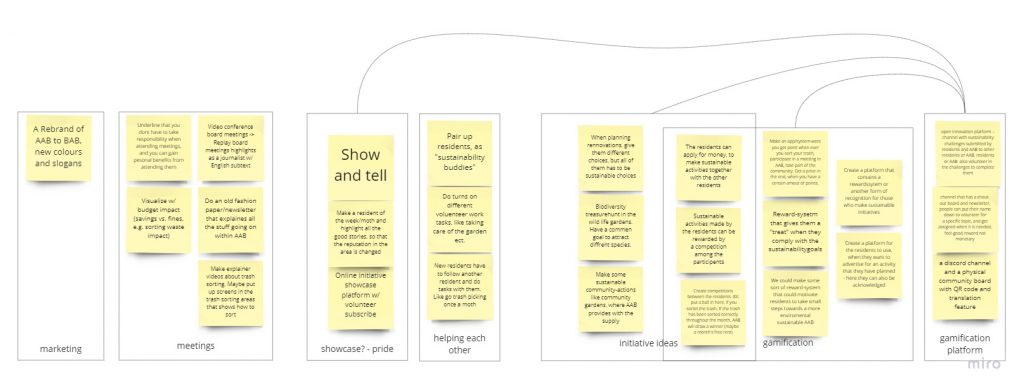
After clustering the solutions, we decided to put the clusterings in the middle of an IDÉ-KÚ, and then reflect over different concepts and solutions to the proposed subjects.

All these suggestions were then voted on by each group member. After that, we made a “heat map” to give an overview of which solutions got the most votes.
Red is the most voted
Dark orange is the second most
Yellow is the third most
No color equals no votes

We then grouped them and made very specific solutions that could be used to develop concepts.
These two solutions are the following.
A platform with four main components where you can
Seek mentorship
Find information regarding the meetings
Apply for help from the community
And complete different sustainability challenges to get rewards.
A Rebrand to help image and cohesiveness
These two solutions enable each other and work together to answer our “HMW”-question, as seen below.
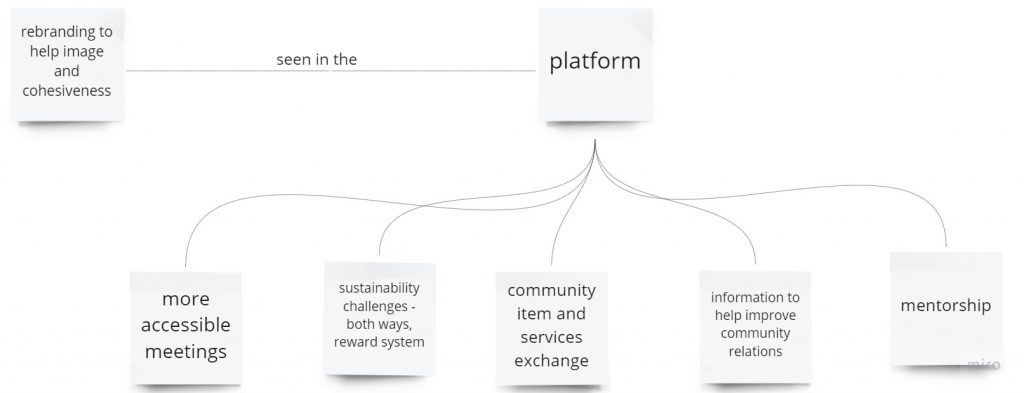
3-5 initial concepts visualized via video/animation
We produced the following video sketches, demonstrating the concepts:
- rebrand
- mentorship
- challenge board
- community
The rebrand video shows how an image change in the residents emerges from a rebrand:
The mentorship video shows how a buddy from the same community helps integrate and empower newcomers in shared ownership:
The community video shows how residents discover and remember to take advantage of community-organized events:
The challenge board video shows how residents find causes and become motivated to improve the community.
1 final concept video/animation with scenario and intro text
After pitching the previous four concepts to our design critique group, we refined our script and combined the different concepts into one narrative with a new combined recording to fit together seamlessly. We also expand on the introduction to better introduce that AAB had already been on a journey to sustainability, and, the transformation into BAB is an acceleration of their progress.
On top of that we made improvements to the props used in the video to give it a more professional look and feel.
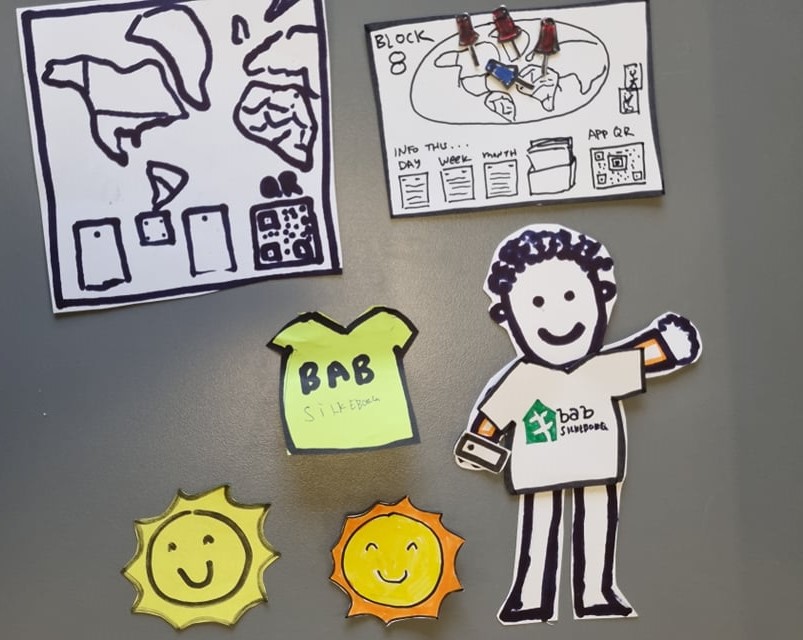
All this taken into account we ended up with a final video sketch which is presented down below.
Final video concept Group 8






